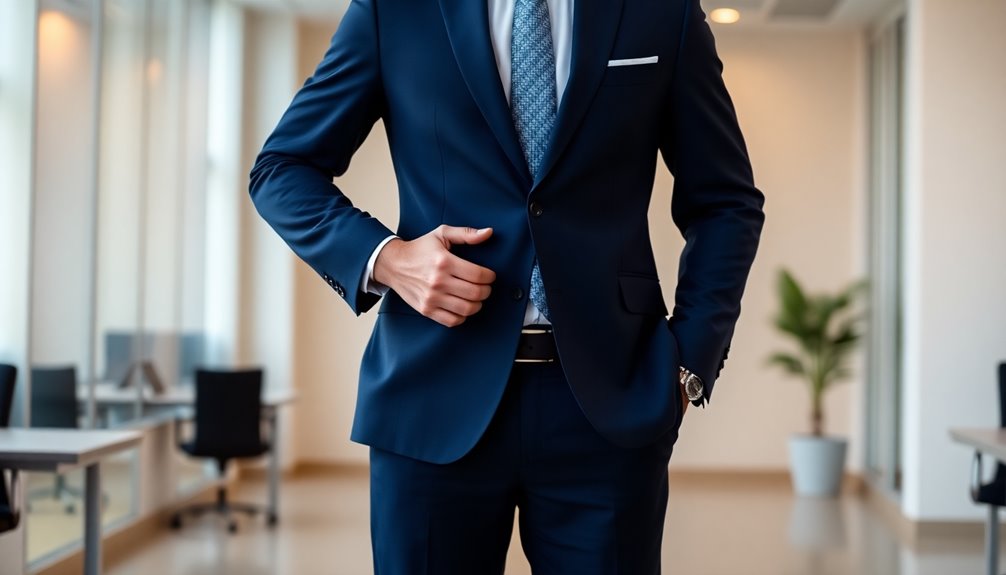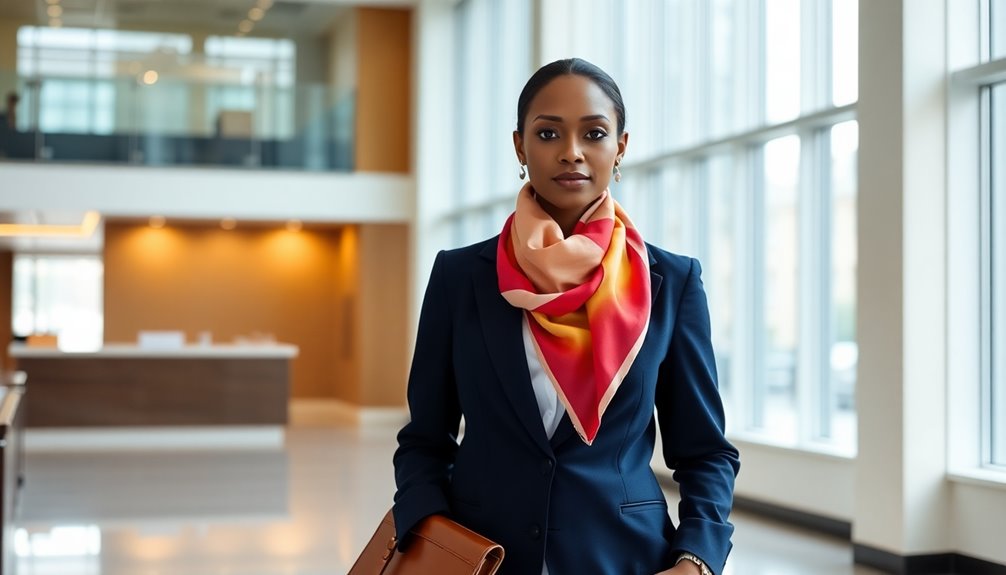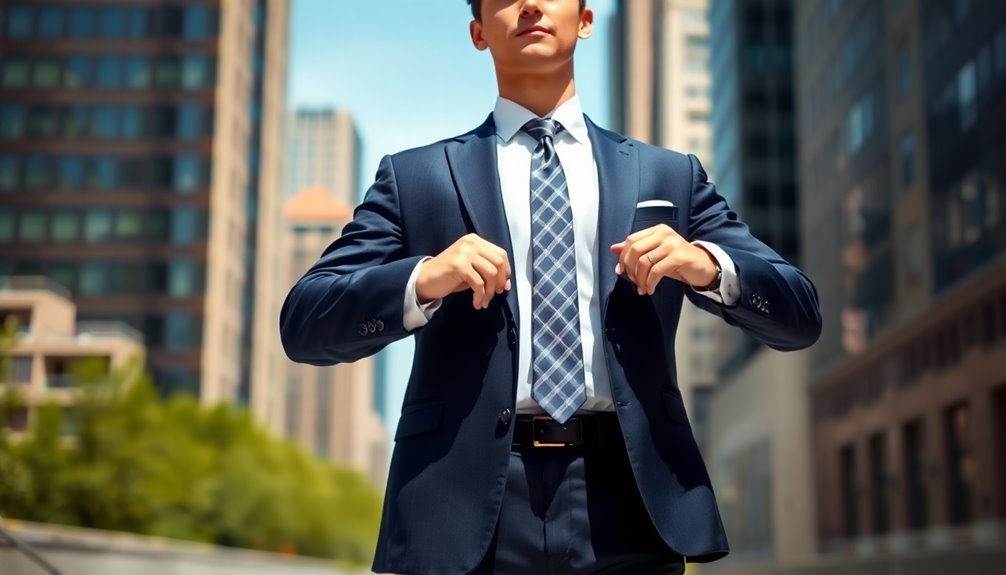Dressing professionally can dramatically boost your hiring odds. When you choose attire that aligns with industry standards, you signal organization and dependability to potential employers. Opt for well-fitted suits or polished business casual outfits that reflect the company culture. Avoid casual wear, loud colors, or distracting accessories, as these can hurt your chances. Remember, first impressions are formed within 15 seconds, so exude confidence with clean, wrinkle-free clothing and minimal accessories. Elevate your professional image, and you might just land that job. Want to know more about perfecting your interview attire? There's so much more to explore!
Key Takeaways
- Dress professionally according to industry standards, opting for tailored outfits that convey competence and attention to detail.
- Choose neutral colors and conservative styles to create a polished appearance that aligns with company culture.
- Avoid casual attire like jeans and sneakers; instead, select well-fitted dress pants or skirts and polished shoes.
- Maintain clean, wrinkle-free clothing and groom yourself neatly to make a strong first impression within the crucial first 15 seconds.
- Invest in quality accessories that enhance your outfit without overshadowing your qualifications, such as simple jewelry and a polished watch.
Significance of Professional Attire

When it comes to job interviews, the significance of professional attire can't be overstated. Dressing formally not only enhances your image but gives you a competitive edge over other candidates. A polished, neat appearance communicates that you're organized and dependable, traits that employers highly value. In fact, the ongoing trend towards casual workplace attire highlights the importance of choosing the right style for your interview context.
When you align your attire with workplace standards, you also demonstrate respect for the opportunity at hand.
Choose simple, professional accessories and hairstyles—they shouldn't distract from your overall presentation. Personal hygiene is essential, too. Clean nails and hands, along with minimal fragrances, can make a positive impression.
It's also important to reflect on the specific workplace environment. For casual workplaces, professional-looking casual attire, like dark jeans and blouses, is appropriate. In business casual settings, opt for dress pants and button-down shirts. If you're headed to a formal workplace, dark suits or tailored dresses work best.
Researching the company's dress code through their social media can provide valuable insights. Remember, when in doubt, it's always better to be overdressed than underdressed. Your attire can set the tone for the interview, so make it count!
How Attire Affects Perception

Your attire plays an essential role in shaping perceptions during the hiring process. First impressions are formed quickly, often within just 15 seconds, and a staggering 55% of how someone perceives you is based on your appearance. When you dress well and groom yourself properly, you send positive signals about your professionalism. A polished, confident look enhances your overall appeal to potential employers.
Research shows that formal attire is associated with higher competence and credibility. Recruiters tend to favor conservative clothing, as it conveys professionalism and reliability. When you choose formal attire, it enhances your perceived intelligence and trustworthiness. Appropriate dressing provides a competitive edge in job hunting, making it even more crucial in today's job market.
On the flip side, wearing the wrong clothes can greatly hurt your chances; 37% of managers have decided against a candidate based solely on their outfit.
Even in more casual work environments, dressing professionally can leave a lasting impression. Aligning your clothing choices with industry standards is essential. Attractive, well-dressed individuals are more likely to receive callbacks for second interviews, while incorrect attire can overshadow even the strongest qualifications.
Understanding Dress Code Policies

Understanding dress code policies is essential for maneuvering the professional landscape effectively. These policies outline expectations for employee attire, aiming to maintain a professional image that reflects the company’s culture and values. They apply to all employees, ensuring a uniform representation, especially during client and visitor interactions. Having a clear understanding of dress code policies allows employees to make informed decisions about their attire for commanding respect in the workplace. It also helps to create a sense of unity and cohesion among team members, fostering a professional and cohesive work environment. By adhering to these policies, employees can demonstrate their commitment to upholding the company’s standards and projecting a positive brand image.
You'll typically encounter various dress codes, from business formal to casual. Business professional attire usually involves suits and ties, while business casual allows for slacks and simple jewelry. Knowing the distinctions is vital, as requirements can vary based on your role and client interactions.
Your appearance matters, so be sure to stay clean and well-groomed, avoiding workout or outdoor clothing. It's important to wear work-appropriate attire that's not revealing or in poor condition, with no visible rips or tears. Employee appearance plays a crucial role in how the company is perceived by clients and visitors.
Additionally, steer clear of clothing with offensive prints.
Best Interview Attire Practices

Choosing the right interview attire can greatly impact your chances of making a good impression. Start by researching the company culture. Determine if they lean toward formal, business casual, or a more creative dress code. Check their website, social media, or ask current employees for insights. Adjust your outfit based on the industry and the specific role's level of formality.
Next, verify your clothes fit well. Ill-fitting clothes can be distracting, so opt for pieces that allow comfortable movement. Breathable fabrics are a must, especially if the weather is warm. When preparing for virtual interviews, remember to dress professionally from head-to-toe to maintain a polished appearance even on camera. Consider incorporating natural materials into your attire for a more authentic look.
Grooming is equally important. Make sure your attire is clean, wrinkle-free, and well-pressed. Avoid excessive cologne or perfume, and keep your hair, makeup, and jewelry simple and professional. Polished shoes are a must, so verify they're in good condition.
Stick to conservative colors and styles. Black, gray, or navy are safe choices for suits and dresses. Avoid flashy or overly trendy pieces, and opt for closed-toe shoes. Matching your jacket with your slacks or skirt helps create a cohesive look that exudes professionalism.
Building a Professional Wardrobe

A well-curated professional wardrobe is essential for making a strong impression in the workplace. Start by researching your industry's dress code standards through social media, company websites, and LinkedIn. This helps you understand what's expected and allows you to dress slightly more formal initially, adjusting as needed. Additionally, utilizing on-campus resources can provide valuable assistance in selecting suitable attire. Developing a growth mindset towards your wardrobe choices can also enhance your confidence during interviews.
Focus on building your wardrobe with essential items. Here's a quick guide:
| Essential Items | Tips for Selection |
|---|---|
| Signature blazer | Choose neutral colors for versatility |
| Quality dress pants | Guarantee a good fit for comfort |
| Professional dresses | Look for styles that suit your body type |
| Dress shoes | Invest in both black and brown |
Consider budget-friendly options like thrift shopping or clothing swaps to refresh your wardrobe without breaking the bank. Mix and match your pieces, and don't hesitate to add a personal touch through accessories. By investing in quality items and being mindful of the workplace culture, you'll build a professional wardrobe that enhances your confidence and boosts your hiring odds.
Sector-Specific Dress Expectations

When you're preparing for an interview, understanding sector-specific dress expectations can make a big difference. In financial services, a polished, formal look is often required, while tech industries might lean towards smart casual attire. Additionally, adhering to dress code policies can help you align with the company's culture and values. Manufacturing roles may focus on practicality, so knowing the norms for each sector helps you present yourself appropriately.
Financial Services Dress Codes
In the financial services sector, dress codes play a crucial role in shaping professional perceptions and expectations. Traditional attire typically includes a well-fitted suit—either a jacket and pants or a jacket and skirt—made from dark colors like black, charcoal, or navy blue.
Men should wear ties with conservative patterns, while polished shoes are a must for everyone. Women can opt for pumps, flats, or stylish heels. Suits are standard attire in the banking industry and investing in quality options shows professionalism. Additionally, maintaining a professional appearance can enhance your credibility, paralleling the importance of maximizing IRA contributions for financial stability.
However, many firms are easing up on dress codes, allowing for business-casual attire, especially in client-facing roles. Companies like J.P. Morgan Chase permit casual pants, skirts, and appropriate tops.
Remember, business casual isn't the same as weekend casual, so keep it polished. When meeting clients, dress at the same level or slightly above to maintain professionalism. Full suits remain the norm in investment banking, while financial advisors may have more flexibility based on their clientele.
Be mindful of specific business settings—what works in one firm mightn't in another. Ultimately, your comfort and confidence in your attire can greatly influence your hiring odds and client attraction.
IT Sector Attire Norms
Maneuvering attire norms in the IT sector can greatly influence your hiring prospects. When preparing for tech interviews, opt for a button-down shirt or blouse paired with dark, fitted pants or chinos.
While a blazer or jacket isn't mandatory, it's recommended for a polished look. Choose closed-toe shoes, ensuring they're polished if appropriate. Keep jewelry minimal—bold or flashy items can distract from your professional image.
In some tech companies, dark jeans are acceptable, but collared shirts are preferred over T-shirts. Avoid flip-flops or sandals, and consider layering with a cardigan or office sweater. Confidence is key in selecting your clothing to ensure you present the best version of yourself.
Patterned socks can subtly showcase your personality without overwhelming your outfit. Underdressing can hurt your chances, so steer clear of shorts, tank tops, leggings, or clothes with holes.
Hats and open-toe shoes are generally not advisable, and make sure everything you wear is wrinkle-free and well-maintained. It's always safer to be slightly overdressed than underdressed.
Lastly, research the company culture to tailor your attire. Large software firms may embrace casual styles, while hardware companies tend to lean conservative.
Observing current employees can provide valuable insight into what's appropriate.
Manufacturing Industry Expectations
Understanding the dress expectations in the manufacturing industry is essential for making a strong impression during interviews or within the workplace. You want to convey professionalism while prioritizing safety. Clothing must promote comfort and safety in factory settings to ensure effective job performance and compliance with best practices.
Here's a quick overview of what to keep in mind:
| Dress Code | Safety Gear | Professional Appearance |
|---|---|---|
| Neat, clean clothing | Reliable work shoes | Tidy and sharp look |
| No torn or frayed items | Gloves and hard hats as needed | Business casual for meetings |
| Avoid inappropriate imagery | Short-sleeve shirts preferred | Minimal jewelry and fragrances |
| Durable pants recommended | Avoid baggy clothing | Change clothes for different areas |
Common Attire Mistakes to Avoid

Many job seekers make essential attire mistakes that can undermine their chances of landing a position. One common error is dressing too casually. If you're interviewing in formal industries like finance or law, avoid jeans, sneakers, and relaxed clothing. Showing up in shorts or flip-flops sends the wrong message.
In addition, be cautious about your color choices. Loud, distracting colors or flashy prints can divert attention away from your qualifications. Stick to neutral or muted colors that convey professionalism.
Revealing or unprofessional clothing is another pitfall. Low-cut shirts, short skirts, or anything too clingy can create a distracting impression. Aim for knee-length skirts and avoid leggings unless paired appropriately. Industry norms can significantly influence what is considered appropriate attire, so it's crucial to tailor your outfit to the specific sector.
Lastly, don't overlook grooming and fit. Messy hair or unkempt appearance can negatively affect your first impression. Guarantee your clothes are clean, pressed, and well-tailored. Avoid white or athletic socks, and choose shoes that are both stylish and comfortable.
The Role of Accessories

When you choose your accessories, think about how they reflect your professional image. Simple and appropriate pieces can enhance your outfit without overshadowing your qualifications. Subtle jewelry is particularly effective in keeping the focus on your skills and experience during an interview.
Choosing Appropriate Accessories
Choosing the right accessories can greatly enhance your professional appearance, especially during a job interview. Stick to small, understated pieces of jewelry that won't overshadow your outfit. Classic stud earrings, a delicate necklace, or a slim bracelet can add just the right touch. Avoid large, flashy, or noisy jewelry that might distract from your qualifications.
When selecting accessories, match them to the style and formality of your attire. For formal settings, conservative options like pearl earrings or a simple watch are ideal. In business-casual environments, you can introduce tasteful pendants or bracelets that reflect your personality while remaining professional. Researching the company culture will help you align your choices accordingly. Understanding the company dress code is essential for making appropriate accessory selections. Additionally, just as in music where collaborative creativity enhances the final piece, your accessories can complement your overall look and show your attention to detail.
Make certain your accessories don't create distractions. Skip jewelry that makes noise or interferes with your movements. A clean, polished look is essential, so confirm your jewelry is in good condition, your nails are well-groomed, and other accessories like watches are tidy.
Finally, avoid excessive or flashy pieces to keep the focus on your qualifications, presenting yourself as a polished candidate ready for the job. It’s essential to create a professional and put-together image during any job application process. This means avoiding distracting or attention-grabbing accessories that may take away from your qualifications. By keeping your look simple and refined, you allow your skills and experience to take center stage. Additionally, keeping communication with the employer polite and professional is crucial, as well as being prepared to discuss average waiting time statistics for the industry during an interview.
Impact on Professional Image
The right accessories can greatly impact your professional image, conveying messages of success and attention to detail. Luxury accessories, like designer watches or sleek leather briefcases, can transform your outfit from ordinary to extraordinary. They evoke sophistication and elegance, setting you apart from the crowd and creating a powerful impression on others. Statistics show that individuals with a polished appearance are often perceived as more competent by their peers. Additionally, the Law of Attraction suggests that projecting a successful image can attract further success into your life.
When you wear high-end accessories, you boost your confidence and present a refined sense of aesthetics. This attention to detail enhances your credibility, making you appear serious, reliable, and successful. Additionally, luxury items can spark interest, opening up networking opportunities due to their distinctive nature.
However, it's crucial to balance sophistication with subtlety. Choose simple earrings or classic hoops that enhance your look without overwhelming it. A delicate chain necklace or a timeless string of pearls can elevate your appearance without being distracting. Stylish, well-designed bags can add elegance while keeping your professional demeanor intact.
Lastly, always align your accessories with workplace culture. Research the company's dress code to guarantee your choices complement the environment, whether it's formal, business casual, or creative. Clean, polished accessories will help maintain a professional appearance.
Tips for Dressing Confidently

Finding the right outfit can greatly impact your confidence during an interview. When you dress well, you not only feel good but also project a positive image to potential employers.
Here are some tips to help you dress confidently:
- Research the Company's Culture: Understand the industry's dress norms and ask current employees about the dress code. Aim to be slightly more formal than the usual attire, as understanding the culture can aid in making a positive first impression.
- Choose Appropriate and Comfortable Attire: Pick clothes that fit well and allow for easy movement. Classic pieces like black trousers or skirts often work best, paired with professional shoes.
- Pay Attention to Accessories and Grooming: Keep your accessories minimal and avoid anything too flashy. Make sure your hair is neat, and your nails are clean. A nice watch or belt can add a polished touch.
- Dress to Inspire Confidence: Wear outfits that make you feel empowered. The right clothing can influence how others perceive you, so choose a style that aligns with the professional image you want to convey.
Frequently Asked Questions
What Colors Are Most Appropriate for Professional Attire?
When choosing colors for professional attire, stick to classic options like navy blue, black, and gray.
These colors convey trust, professionalism, and analytical skills, making them ideal for interviews. White shirts are great for a clean look, while avoiding bright or bold colors helps maintain a serious tone.
How Does Cultural Background Influence Professional Dress Expectations?
Cultural background plays a significant role in shaping professional dress expectations. When you understand these influences, you can navigate workplace attire more effectively.
For instance, if you're from a culture that values modesty, you might opt for longer sleeves and conservative cuts. Conversely, in creative fields, you might express your individuality through bold choices.
Recognizing and respecting diverse dress norms fosters inclusivity and can enhance your professional relationships in a multicultural environment.
Can Wearing Accessories Impact Hiring Decisions?
Yes, wearing accessories can impact hiring decisions. When you choose the right accessories, they can enhance your professional look and show attention to detail.
However, if they're too flashy or distracting, they might overshadow your qualifications. It's important to select simple, elegant pieces that align with the company culture, as this illustrates your understanding of the workplace.
Is It Acceptable to Wear Open-Toed Shoes in Interviews?
Did you know that 55% of first impressions come from appearance? When it comes to interviews, open-toed shoes generally aren't a safe choice. They can appear too casual and distract from your professional image.
In traditional industries, closed-toe shoes are often mandatory. If you're applying in a creative field, check the dress code first.
Prioritize comfort and quality, ensuring your footwear aligns with the company culture to make a strong impression.
How Do Personal Styles Align With Professional Dress Codes?
Personal style can align with professional dress codes by incorporating subtle elements that reflect who you're while adhering to industry standards.
You can choose unique accessories or well-tailored pieces that maintain professionalism. Understanding your company's culture is essential; for example, formal industries might require a more polished look, while creative fields may allow for relaxation.
Ultimately, your choices should enhance your confidence without compromising the expectations of the workplace.
Conclusion
In the grand theater of job interviews, your attire is your costume, setting the stage for success. By dressing thoughtfully, you not only reflect professionalism but also boost your confidence—a silent partner in your performance. Remember, just as a well-rehearsed actor captivates an audience, your polished appearance can leave a lasting impression. So, embrace the power of your wardrobe, avoid common pitfalls, and step into that interview ready to steal the spotlight. You've got this!
Emmeline is the backbone of our content creation team, bringing complex psychological concepts to life with clarity and empathy. As our Expert Writer, she crafts engaging, insightful articles that guide readers through the intricacies of personality assessments and what they reveal about the human condition. Her passion for psychology and personal development shines through in every piece she writes.










